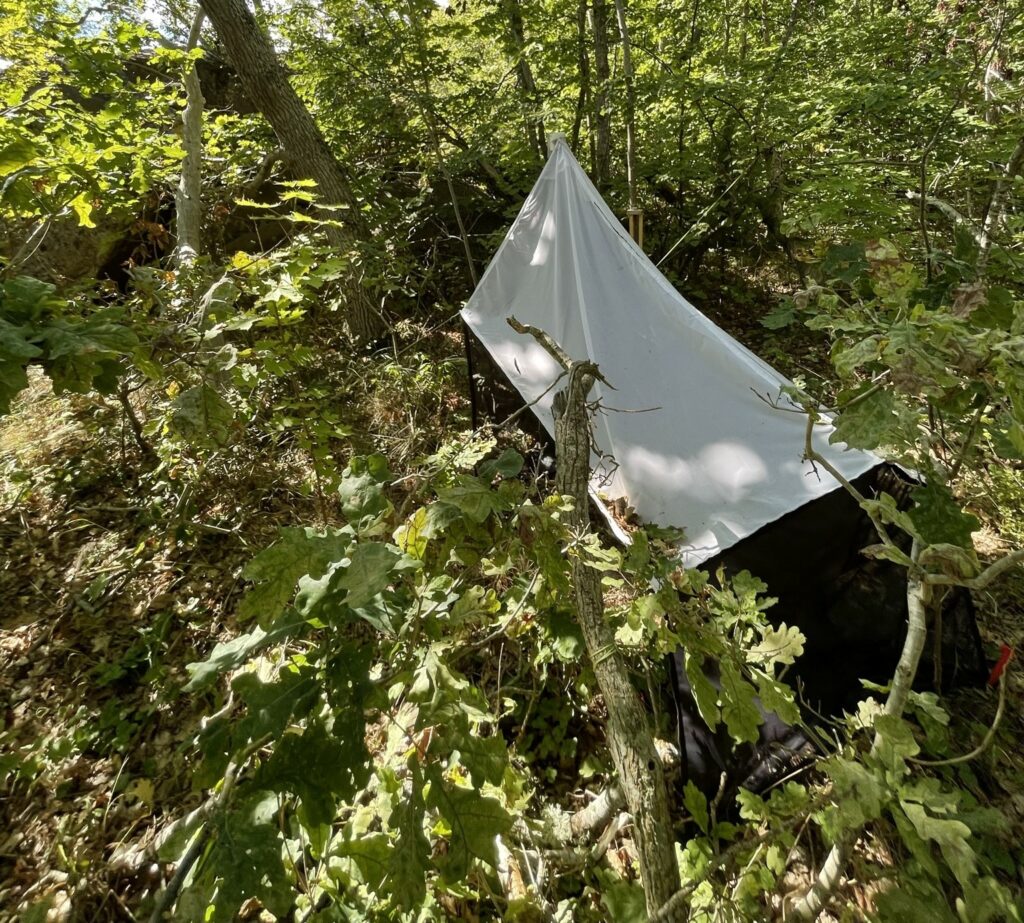In this section, we present the methodologies used in our study. Our approach combines traditional field techniques and modern scientific analyses to explore the health, growth, and biodiversity of oak ecosystems. Each method is tailored to address specific research questions:
Herbivory and mildew assessment
Objective: Assess the prevalence of herbivory and powdery mildew on oak leaves, identifying specific gall and miner species present.
Collection: Utilize an arborist throw-line launcher to collect 30 sun-exposed leaves from the crowns of each oak tree at 31 different sites.
Storage: Store leaves dry in envelopes to preserve their physical state until analysis.
Examination: Examine each leaf under a microscope to identify and record instances of herbivory damage and powdery mildew presence. Galls and miners should be identified at the species level where possible.
Objective: Determine oak trees’ age and growth rates within and between studied oak stands.
Sample collection: Use a Haglöf 2-thread increment borer to extract a bark-to-pith core sample from each tree 1.3 meters above ground level.
Sample storage: Store core samples in marked plastic straws, sealed with masking tape to prevent damage and contamination.
Analysis: Analyze core samples to measure tree growth rings, noting variations that may indicate environmental impacts or anomalies in growth patterns.
Objective: Measure and compare the diameter at breast height (DBH) and height of oak trees across sites.
Tools: Measure DBH using Haglöf Mantax Blue Klave calipers and determine tree height using a Suunto PM-5/1520 clinometer.
Data recording: Record measurements using the Field Maps app (ESRI), which will also geo-tag the location, date, and time of the measurement.
Objective: Monitor bird and bat species’ diversity and activity patterns across oak stands.
Equipment setup: Deploy two AudioMoth 1.1.0 devices per site; one records bird sounds at 48 kHz, and the other records bat echolocations at 192 kHz.
Recording schedule: Set devices to record for one minute every ten minutes.
Data usage: Analyze recordings to identify species presence and activity patterns, correlating these with habitat characteristics.
Objective: Assess arthropod species richness, abundance, and size distribution.
Trap setup: Install Malaise traps at each site, ensuring they are positioned to capture flying insects effectively.
Sample handling: Store samples in ethanol within Nalgene bottles and divide them into two-size fractions using sieves.
Metabarcoding: Send samples for DNA barcoding to identify species present, using the COI marker to aid in species identification and abundance estimation.
Objective: Document the species composition and environmental characteristics of oak stands.
Sampling technique: Establish four vegetation plots around each tree, measuring 0.5 m² each, in the four cardinal directions.
Data collection: Record all vascular plant species within each plot, using Ellenberg values to infer environmental conditions such as soil moisture and light availability.
Objective: Evaluate tree species richness, frequency, and the basal area of dead-standing wood within oak stands.
Equipment: Utilize a Relascope with a prism 1 (Bitterlich, 1984) to measure the basal area and diameter class distribution.
Procedure: At each site, align the Relascope perpendicular to the ground and record basal area measurements for living and dead-standing trees at a standard height of 1.3 meters.
Documentation: Note each measurement and specific tree species to assess richness and frequency within the stand.
Objective: Analyze oak trees’ genetic diversity and population structure across various stands.
Sample collection: Use an arborist throw-line launcher to collect sun-exposed leaves from tree crowns, ensuring a broad genetic sampling.
Storage and processing: Store leaves at -20°C immediately after collection. Extract DNA in the laboratory and conduct RADseq analyses at SciLifeLab.
Data analysis: Perform bioinformatic analyses on remote computers at SNIC-UPPMAX to interpret genetic data, focusing on population structure and diversity.
Objective: Monitor and analyse variations in light and temperature within oak stands and their influence on ecological dynamics.
Equipment setup: Install HOBO MX2202 pendant wireless temperature/light data loggers in shaded areas 0.5 m above the ground.
Data recording: Loggers record temperature and light at hourly intervals. The data can be accessed and downloaded using the HOBOconnect app.
Analysis: Use recorded data to assess environmental conditions’ effects on tree growth, species composition, and animal activity patterns.
Objective: Measure infestation rates of the Acrocercops brongniardellus moth across Sweden.
Sampling sites: Assess 35 sites, including 5 heavily infested locations, to understand the distribution and intensity of infestations.
Data collection: Regular monitoring and recording of moth populations and damage levels at each site, employing standard entomological survey techniques.
Objective: Investigate the ecology and evolution of Saccharomyces yeast species on oak.
Sample collection: Collect bark samples from 28 native oaks, five project-designated trees, and three old oaks, targeting areas known for yeast colonisation.
Analysis: Conduct genetic sequencing and ecological assessments to understand yeast distributions and their interactions with the oak bark environment.
Objective: Determine if oak regeneration is influenced by latitude and stand characteristics.
Sampling framework: Examine 28 native oak and three red oak locations for signs of natural regeneration.
Data collection: Measure sapling counts, sizes, and growth rates, correlating these with geographic and environmental variables.
Objective: Quantify insect biomass within oak forests to understand the dynamics of ecological health and the food web.
Methods: Deploy standardised insect traps to collect and measure insect biomass periodically across selected sites.
Analysis: Analyze collected samples to assess biomass and its seasonal variations, linking these to habitat conditions.
Objective: Assess the richness of lichen and moss species on native and exotic oak trees to understand their ecological roles.
Collection strategy: Sample lichens and mosses from 28 native oak and 14 red oak trees.
Analysis approach: Identify and catalogue species to assess diversity and its ecological implications.




